Cambodia, June 2013: Cambodia by bike part 2
Country: Cambodia
From Kratie to Kampong Cham
Lesson learned: If you want to find the main road just follow the power cable
Laughed about: “I love you too!”
Most wonderful miracle: One last swim in the Mekong at sunset
Food we ate: No bugs
Greatest challenge: Politely try to finish the weirdest fruit shake ever
Days on the bike: 1 1/2
Kilometers cycled: 130
Average Kilometers per day: 86.66
Total Kilometers cycled till Kampong Cham 10961.38
Total days travelled till Kampong Cham: 640
The Mekong Discovery Trail was invented to increase tourism in the North of the Cambodia. What a great idea. I unfolded the map again and hoped that this time it would make more sense to me, but it did not. In most maps thick and thin strokes stand for big and small roads. The Discovery Trail map only has plenty of multi-colored lines.
I compared the colorful spaghetti roads with the photo of the map from the guest house in Kratie. There was hardly anything they had in common apart from the Mekong and a few town names. Google Maps had given me even another picture. But there was no internet. Compared to many others we were quite some old-school cyclists without Smartphone or GPS. There was nobody to ask so we just got started. What could go wrong? As long as we did not cross the highway to the left and did not fall into the Mekong on the right, we would head towards the right direction. That was enough.
After half a kilometer on a bumpy sandy path right on the shore I heard trucks blowing their horns somewhere nearby. Only 100 meters parallel there ran a small paved road with perfect conditions: not too much traffic, many villages and rice fields but as usual no shade. We stopped at a gas station. Not that we needed gas but there was space to lean our bikes. While I filled our water bottles, Roberto befriended a family that shelled beetles.
There they sat on an empty bed frame and on top of an old and empty ice box right next to the gas pumps. They picked one of the beetles that were crawling in the big beetles bowl, tore out its wings and legs and put it back into a basket. Later all the insects would be grilled and eaten.
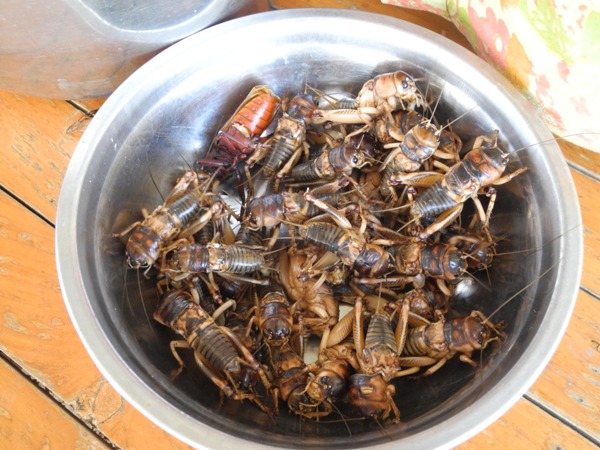
Every now and then one of the bugs tried to escape, but they did not come far, because the sheller’s trained eyes put them back right away.
The sun shone hard. We cycled past fields, through villages and construction sites, next to semi-finished bridges and plenty of Buddhist temples. Here they called them Pagodas. In Laos they were known as Watts and back in Thailand everybody called them Temples. I have to admit that for my untrained eye they look quite alike.
We take our second break of the day at a fruit shake stand. Roberto asked for melon. What we got were two brown strange smelling beverages with bubbles. My first thought was “whisked shit” (German old fashioned swear word). But after a few sips we would find out the ingredients. To clarify: It did not contain any feces
The color must have come from cocoa powder. The weird smell was Durian fruit and the bubbles were made by mixed up raw egg white. I like each of the ingredients. But as a shake it tasted horrible. The straw stood in the solid foam and the glass did not seem to get any emptier no matter how much I drank. The saleswoman watched over. I smiled towards her. When she left I held my nose and downed nearly everything at once. Ugh.
When the lady saw our empty glasses she appeared very happy. If I had complained about the wrong shake she would have lost her face. The culture’s sake. I ate a few pieces of bread to get rid of the funny taste and got on the bike again.
After a while there were fewer pagodas around us and more mosques. They were blank polished and looked as if they had been just opened yesterday. The white walls glared me. We saw many houses made from wood, banana leaves and in the Buddhist villages and plenty of stone houses in the Muslim villages.
After 60 kilometers we made the third break. There was no electricity and the ice in the coolers in the village café had melted into water. No matter, even a lukewarm Fanta tasted better than hot old water or even durian egg-chocolate shake. At the next table a couple of girls were giggling over their sundaes. They wore their headscarves deep. Right next to I saw one of the Buddhist Spirit Houses, believed to appease the spirit of the Buddhist house café owner.
Back on the track the road branched up in two directions again. Which way to go? There was nobody around so we decided for the right side. Next to the Mekong we knew we could not be wrong. The road was not paved anymore but the dust and bumps did not bother us at all. We cycled along big villas, small huts, and more mosques and pagodas. The children were more than excited when they saw us. Many ran after us, others called continuously “Ilo! Ilo! Ilooooo “. Funny pronunciation for Hello. Seems like the village’s English teacher could use some classes himself.
Even aged women, young mothers, old men and teenagers waved at us with big smiles in their faces. I cycled one-handed permanently because the other hand was busy drinking water, waving, wiping sweat, waving, searching for the camera in the handlebar bag and waving again. Close to schools, we also got to hear “What’s your name”. I answered that one. The answer for “I love you” usually came from Roberto. The bearded thirty-year old man who shouts “I love you too” to some six-year old boy made me laugh every time. But I was happy to see that the three sentences that most children learned were positive ones.
Many men wore short red and white checkered wrap skirts, most young children were naked. We overtook cyclists who carried living chicken, presumably dead giant pigs and all kinds of vegetables on their wobbly bikes. Our bicycles appeared rather handy and lightweight next to them.
After nearly 100 kilometers we started to search for a pagoda. While Roberto stopped for a quick photo, a young woman came up to me. Her name was Bunny and she taught English at a school nearby. I grinned. The pronunciation of the children had actually improved noticeably within the last few kilometers. Bunny invited us to spend the night at her house. That sounded great! Bunny asked whether we can swim and then sent us directly to the Mekong. “Go and refresh yourselves”, she said. What a great idea.
We parked the bikes and walked through a couple of fields to the shore. The water was cool and the current quite soft. Soon a group of boys joined us, then a farmer with his cow. He led his cow gently into the water and then scrubbed it clean while the boys jumped around. A second farmer with two other cows joined us and we swam with them until the sun set on the other side of the river. What a perfect farewell to the Mekong River, which was a faithful companion to us for about 1300 kilometers.
Bunny lived in a bamboo house on stilts. There were two rooms: the kitchen and the living room. The cows lived under the house. I grabbed facecloth and detergent and joined them, because Bunny’s water bucket was standing under the house as well. Two women looked over to me curiously while I scrubbed myself fully dressed. I was not as experienced in this way of taking a shower in public and behaved quite stupidly. At the end the dress was soaking wet, and I had not even washed my hair.
Bunny cooked and I transformed the tomatoes and cucumbers that we had brought, into a tasty salad. For dinner and her little sister, her brother, grandfather and parents came by. Bunny would not see her fiancé until January. He lived in South Korea, where he was able to earn more money than in Cambodia. After dinner, we got through a large pile of Bunny’s family photos. Then we went to sleep. There was zero traffic noises outside, the beetles crawled next to my head, flies and mosquitoes buzzed and crickets chirped. Occasionally I heard some cow dung splashing on the ground under the house.
We left early next morning because it was hot again. The bumpy road branched off again and again. Every time we asked a local for the way. At the tenth time we got a great tip: Always follow the power cable!
Sometimes the road was muddy. I had to continue highly concentrated, fast and without moving the handlebar if I did not want to fall into the deep mud. Roberto succeeded only partially. He sank into a mud pile. His foot was smeared with so much mud that his shoe was not even visible anymore. Roberto uttered plenty of Spanish swear words and I doubled up with laughter.
A farmer had mercy and Roberto scrubbed his shoe ad foot his water and detergent. The procedure took a while and when he was ready, half the village had gathered in the front yard watching him.
After 35 kilometers we reached the bridge. On the other side the city awaited us. Loud horns, a petrol station with air conditioning and heavily laden mini buses made us leave Kampong Cham as fast as we had entered it. We waved goodbye to the Mekong and quickly cycled out of the city. I just hoped that the traffic would not stay that crazy all the way to Siem Reap.
herausfinden.

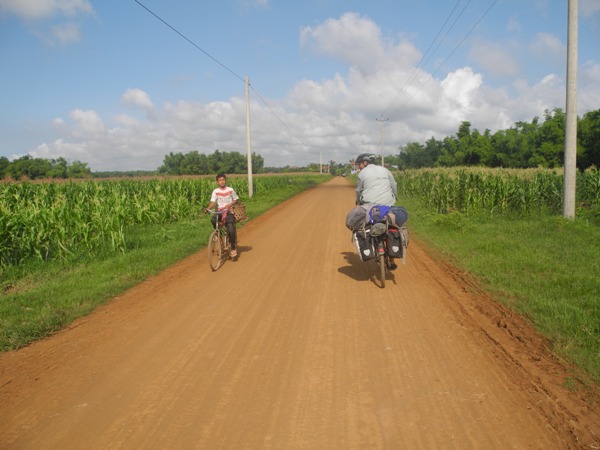
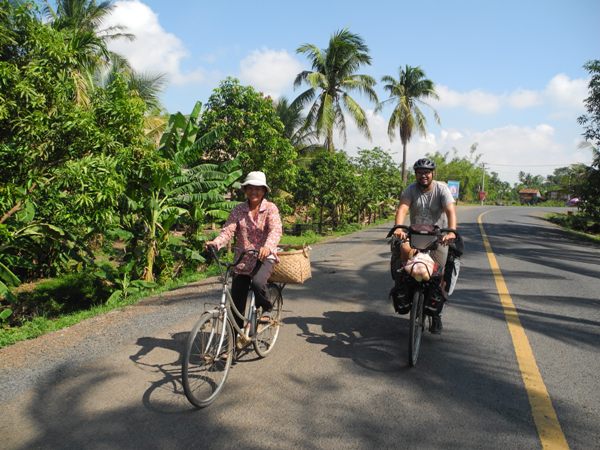

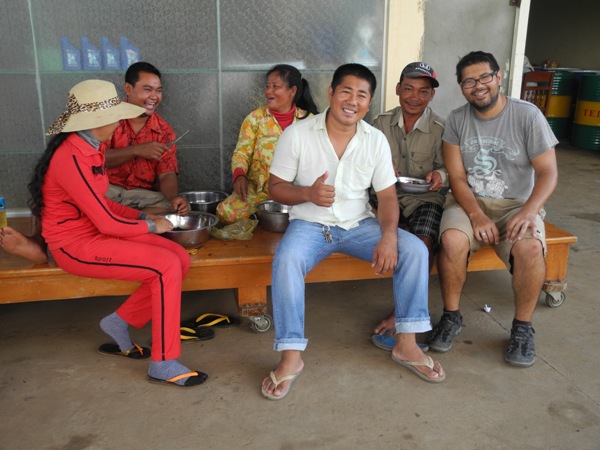
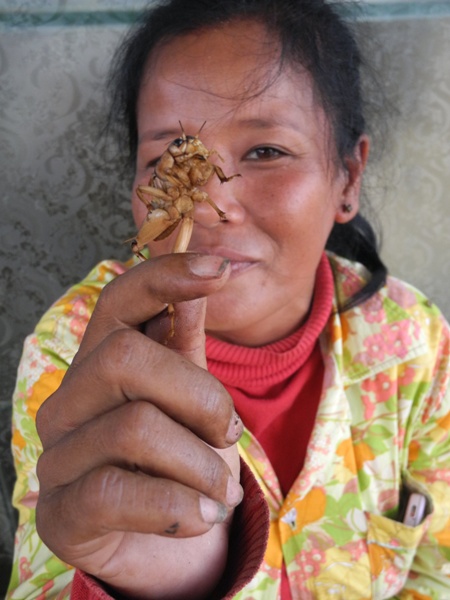

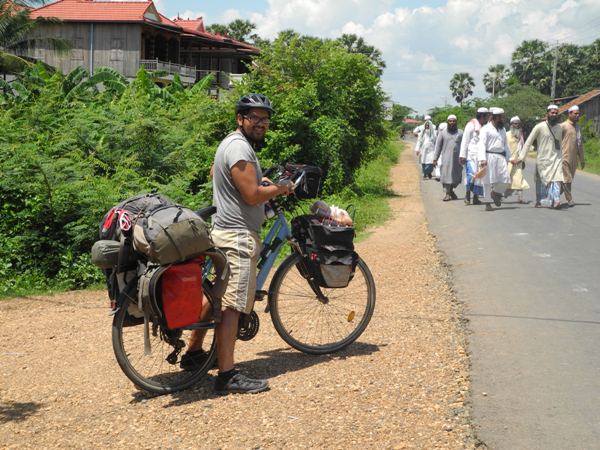
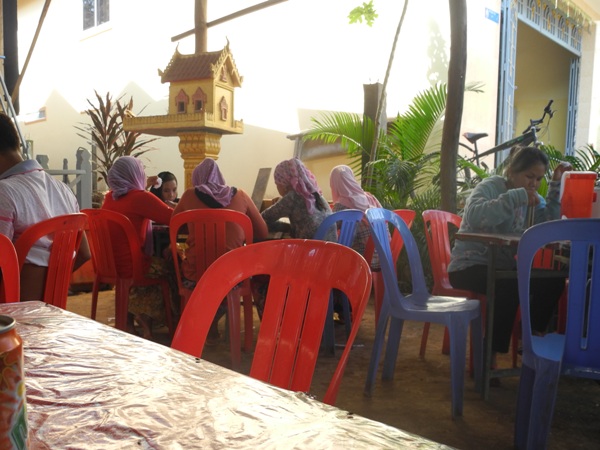
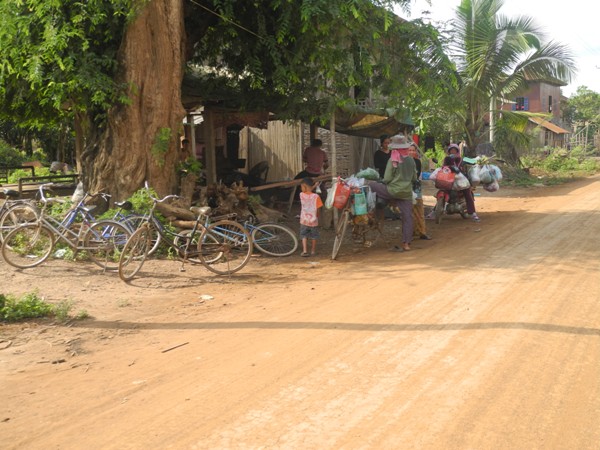
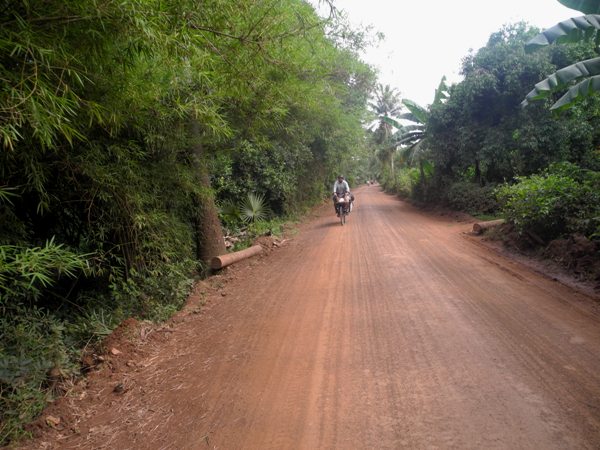
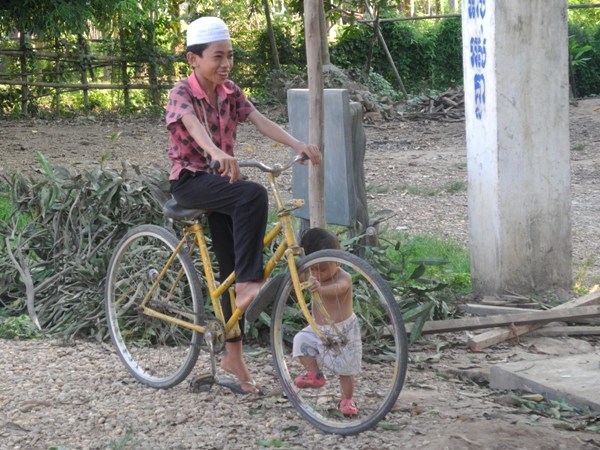
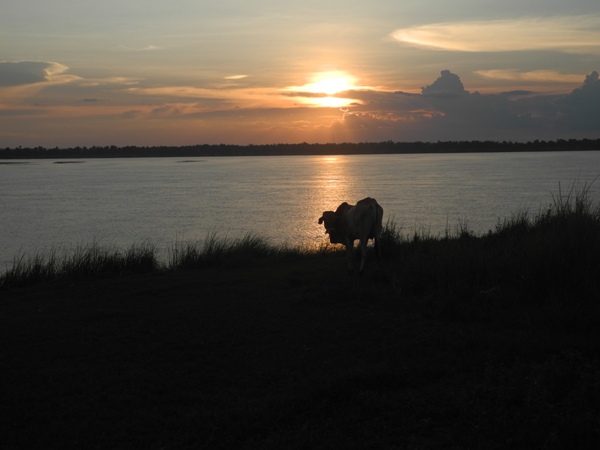
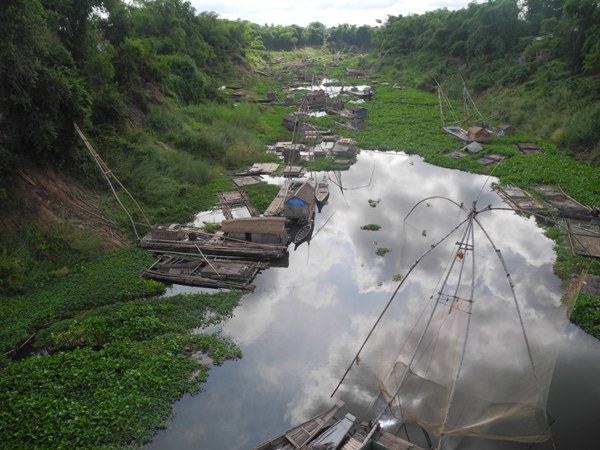
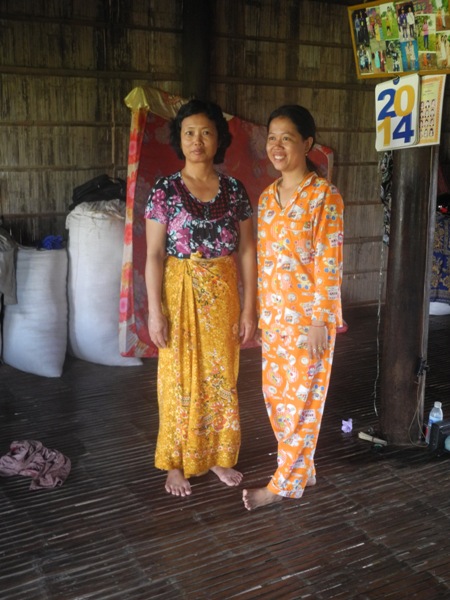
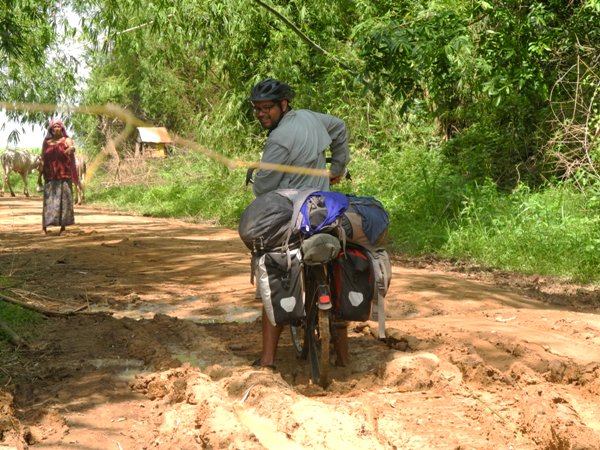
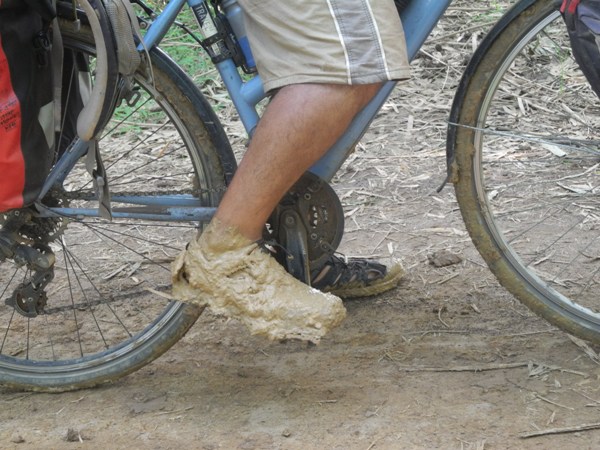
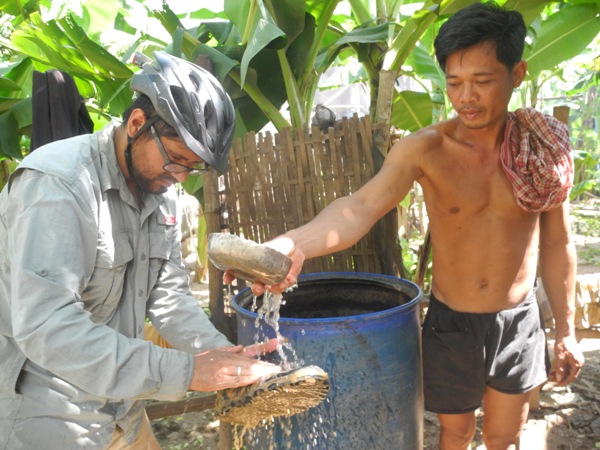
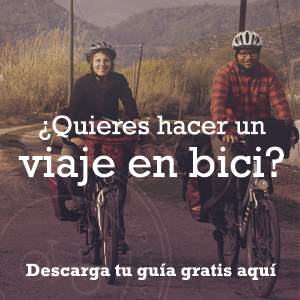




Recent Comments